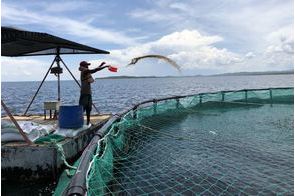How to create wealth through agriculture in Africa

Summary
While both the employed and the unemployed across Africa have been encouraged to engage in agriculture, the focus has been on hunger reduction. Not much has been done to facilitate wealth creation through agriculture.
This month, international leaders, farmers, agribusiness executives and development experts from across the globe will get together in Des Moines, Iowa, in the United States, for the yearly symposium known as the Borlaug Dialogue, to reflect on key challenges facing global food security and nutrition. The international symposium is organised annually by the World Food Prize Foundation.
Africa is expected to feature prominently in the three-day programme, beginning from the 18th. President of the African Development Bank (AfDB), Akinwumi Adesina, who is the 2017 World Food Prize Laureate, will speak at the event. And the theme of the conference is: “The Road Out of Poverty.”
Part of the reason Africa will feature in the discussions is because the continent continues to be affected by food insecurity, exacerbated by conflicts and climate change. Africa's food insecurity has become a global concern.
This year, the Borlaug Dialogue will look at agriculture's potential to lift people out of poverty. As Adesina and others have argued, for Africa to be food-secure, the agriculture sector should not only focus on solving hunger problems; it needs to focus also on solving economic problems. African agriculture has the potential to generate wealth and improve the lives of an estimated 767 million people living in extreme poverty on the continent – and lift them out of poverty.
Food insecurity is the most basic form of poverty. According to the World Food Programme, hunger leads to a vicious cycle of poverty. When people lack nutritious foods, they are weaker or sick, and, therefore, less able to work to earn the money they need. Data from the International Monetary Fund's World Economic Outlook shows that African countries dominate the ranking of the 25 poorest nations in the world. Only four – Haiti, Kiribati, Afghanistan and Solomon Islands – out of these 25 nations are not in Africa. Over 41 percent of the population of sub-Saharan Africa lives in extreme poverty – that is, they live on $1.90 or less daily.
According to the World Bank, the vast majority of the global poor who live in rural areas and are poorly educated, or not educated at all, are employed in the agricultural sector. And about 46 percent of the world's population lives in rural areas. In Malawi, Burundi, Ethiopia, Niger, and South Sudan, this figure climbs to over 80 percent.
Almost every country in Africa is turning to the agriculture sector to help create more jobs for unskilled labourers. Most countries have realised that agriculture has the potential to meet the needs of the more than 41 percent of illiterate African adults and rural poor across the continent.
But while both the employed and the unemployed across Africa have been encouraged to engage in agriculture, the focus has been on hunger reduction. Not much has been done to facilitate wealth creation through agriculture.
For Africa's agriculture to become globally competitive, the continent needs to diversify from trading produce to developing value chains in the sector. It's time we took advantage of our rapidly growing population for the production, processing, marketing and distribution of our own products. African governments have huge roles to play to achieve this.
Take the case of cocoa as an example. Currently, our farmers cultivate cocoa that is then exported to developed countries at relatively low prices. The exported cocoa is then processed into chocolates and beverages, which are imported to African countries at higher prices. This trade pattern is part of what ensures that our farmers are stuck in a poverty trap. Seventy percent of the world's cocoa beans come from four West African countries: Ivory Coast, Ghana, Nigeria and Cameroon. However, only two percent of what is produced is processed locally in these countries.
To change this, we need to invest in building our local processing capacity so that we can consume locally-manufactured products, and also export some for foreign exchange. This involves a paradigm shift from simply increasing yield to producing finished goods. Such value addition will help prevent waste, feed Africa and boost the income of farmers and agribusiness operators.
Various food technologies are currently available in different parts of the world to make food processing possible. Such technologies are available for farm products such as maize, cassava and other locally produced staple foods. With access to these technologies, maize farmers can increase the value of their crops by processing it into maize flour to feed both humans and livestock. Educational institutions in African countries could also be supported to carry out and implement research to produce high-yielding varieties of crops and improve food nutrients. Certainly, this approach would be financially demanding at the outset. However, the payoff could be huge.
According to stakeholders, Nigeria loses over $2.5 billion annually due to a weakened cocoa production capacity and lack of processing capacity for the crop. In Kenya, the commercial maize flour market is expected to rise from $315.8 million in 2015 to $444 million by 2020 at a CAGR (Compound Annual Growth Rate) of 7.1 percent; while the market for posho maize flour is expected to increase from $658.2 million in 2015 to $840.2 million by 2020 at a CAGR of 5 percent, according to Frost and Sullivan. (Posho, which accounts for the bulk of the maize flour market in Kenya, provides inferior-quality flour at cheaper prices for price-sensitive consumers.)
According to Adesina, Africa imports $35 billion worth of food every year. This figure is projected to grow to $110 billion by 2025. By expanding domestic production and producing finished agricultural goods that meet global standards, African countries can reduce importation of food items in favour of increased exports.
But in order to do so, we must ensure that African products are appealing to Africans. Over the years, I have observed a drastic reduction in the appetite of Africans for locally produced foods that used to be very peculiar to different tribes and ethnic groups. Younger generations of Africans living in urban areas have increasingly developed appetites for foreign foods.
To boost the output of the agriculture sector and improve its profitability – as well as prepare for the future challenge of feeding a much larger population – there is a need to expand domestic food production, increase the standard of finished products and raise the appeal of locally-processed foods for urban dwellers. Many times, consumers move away from a local product because quality is not guaranteed. One way to restore consumers' confidence is to maintain good quality and improve packaging, while keeping prices as affordable as possible.
For us to significantly improve output and accelerate agricultural development, generous investment in rural infrastructure is essential and should feature high on our list of priorities. To be sure, infrastructure projects require huge capital outlays; they also involve long maturity periods and oftentimes low rates of return.
However, rural infrastructure is a strong determinant in the ability of farmers to access institutional finance and markets. Given that most agricultural activities take place in rural areas, rural infrastructure can transform subsistence agriculture in many parts of Africa and other developing countries into modern commercial farming systems.
Rural agricultural infrastructure includes physical infrastructure (road connectivity, storage, processing and preservation facilities); resource-based infrastructures (irrigation and public access to water, farm power/energy and rural electrification); input-based infrastructure (improved seeds, fertilizer, farm equipment and machinery); and institutional infrastructure (extension and education technologies to improve rural literacy, agricultural research, information and communication services, financial and credit institutions, extensive marketing platforms and health services).
As proven over time, adequate infrastructure raises farm productivity and reduces farming costs. Investing in infrastructure generally plays a strategic role in producing multiplier effects in the economy. According to a research by the World Bank, this means that doubling infrastructure capital raises Gross Domestic Product (GDP) – one of the primary indicators used to measure the health of a country's economy – by roughly 10 percent.
The wealth creation potential of the agriculture sector can become a reality in Africa if we look beyond just growing crops and rearing animals for food, to applying technology and adding value to harvested products.
Financial Nigeria Columnist, Mojisola Ojebode, is a Nigerian biochemist and the founder and product developer at Moepelorse Bio Resources. She is also a Global Innovation Through Science and Technology (GIST) awardee, a Mandela Washington fellow, and an Aspen New Voices fellow.
Related
-
In Nigeria’s steady progress in agriculture, potential history is in the making
It’s so critical to develop a new agriculture investment plan that shows Nigeria is committed to ensuring agriculture ...
-
Finnfund invests $6 million to expand aquaculture in Zambia
Finnfund made the investment in an integrated tilapia aquaculture company, producing 12,000 tonnes of tilapia annually.
-
IFAD to provide $40mn loan for Sub-Saharan Africa Aquaculture Programme
IFAD stated that the programme will pay special attention to women and youth.







